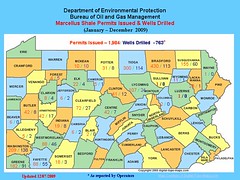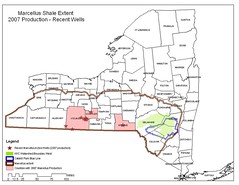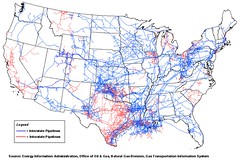COMMONWEALTH OF PENNSYLVANIA
Dept. of Environmental Protection
Commonwealth News Bureau
Room 308, Main Capitol Building
Harrisburg PA., 17120
HARRISBURG -- High levels of total dissolved solids pollution from natural gas drilling and other sources pose a real threat to Pennsylvania’s streams and rivers, including aquatic life, warned Department of Environmental Protection Secretary John Hanger today.
“The treating and disposing of gas drilling brine and fracturing wastewater is a significant challenge for the natural gas industry because of its exceptionally high TDS concentrations,” said Hanger. “Marcellus drilling is growing rapidly and our rules must be strengthened now to prevent our waterways from being seriously harmed in the future.”
Hanger pointed to recent examples where TDS impaired streams and affected major sources of drinking water.
In 2008 and 2009, TDS levels exceeded drinking water standards along the Monongahela River, which is a major source of drinking water. Drinking water treatment plants do not have the equipment available to remove TDS, so any water polluted with TDS goes into Pennsylvania’s homes and businesses.
Similarly, in early September 2009, excessive TDS levels led to an environmental disaster that wiped out 26 miles of Dunkard Creek in Greene County, as well as many miles of the creek in West Virginia. These high TDS concentrations, coupled with other factors such as temperature and nutrient concentrations, enabled golden algae to bloom and created an inhospitable environment for aquatic life. The algae released toxins to the water column that literally wiped out aquatic life, including at least 16 species of freshwater mussels and 18 species of fish.
Dunkard Creek is an example of what can happen if TDS is not controlled, said Hanger, and the loss of this important public resource was an environmental and economic tragedy.
TDS is a measure of all elements dissolved in water that can include carbonates, chlorides, sulfates, nitrates, sodium, potassium, calcium and magnesium. In addition to natural gas drilling, other sources of TDS include, abandoned mine drainage, agricultural runoff, and discharges from industrial or sewage treatment plants.
For more information, visit www.depweb@state.pa.us.
DEMAND ACCOUNTABILITY!



















HTTP://energyindustryphotos.com/what_is_hydraulic_fracturing.htm
ReplyDeleteread this site see chemicals and look up their health effects . REALLY IMPORTANT !!!!!!!!!